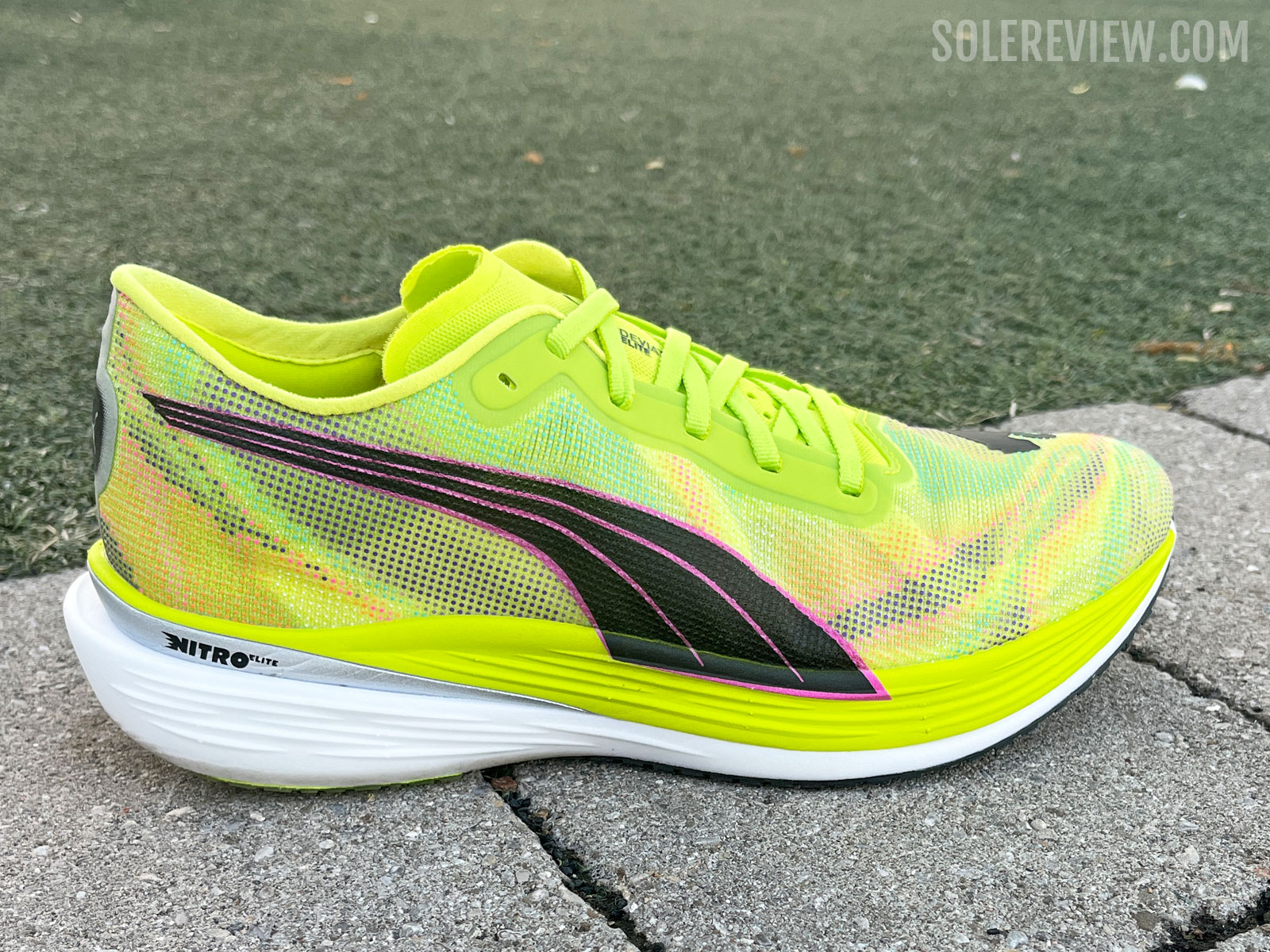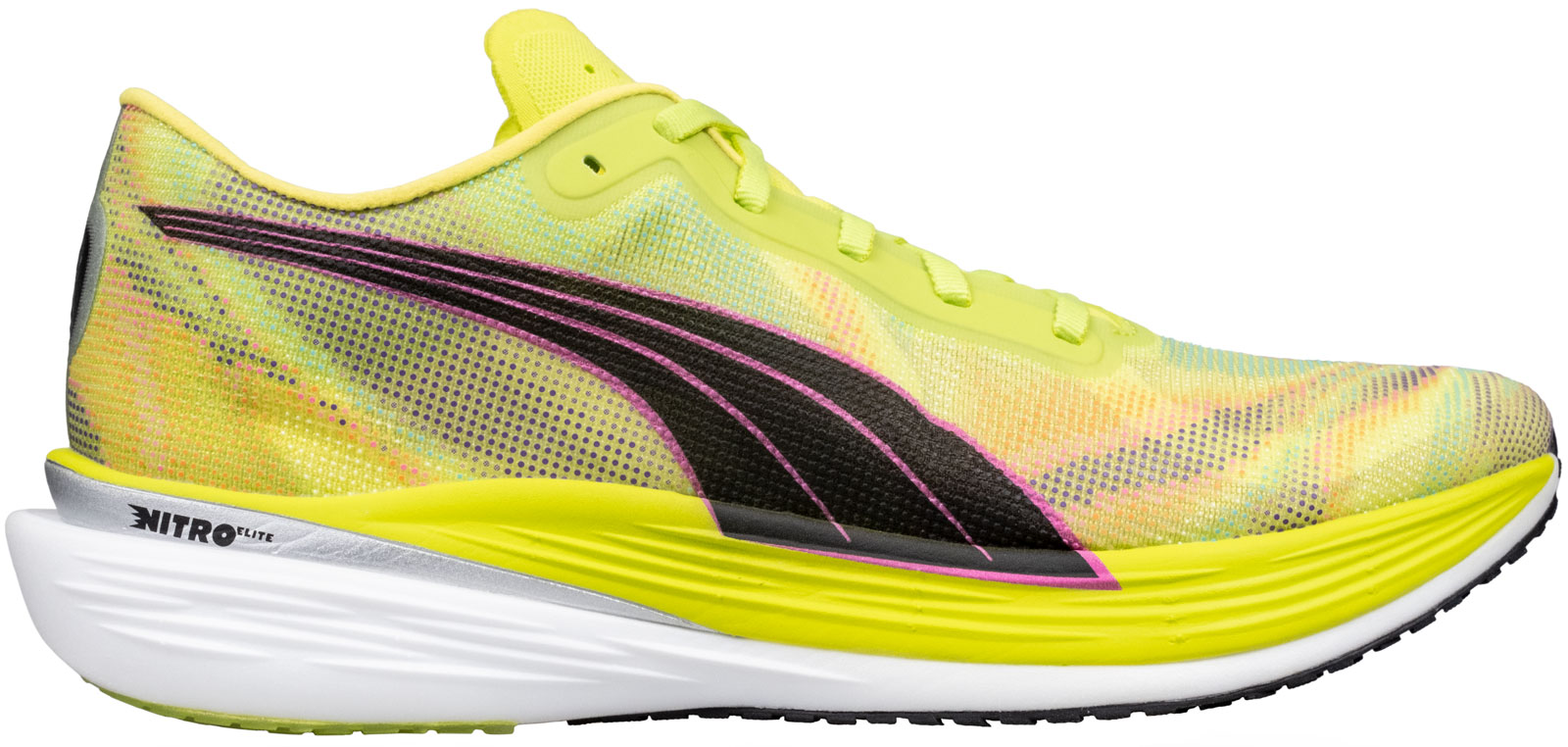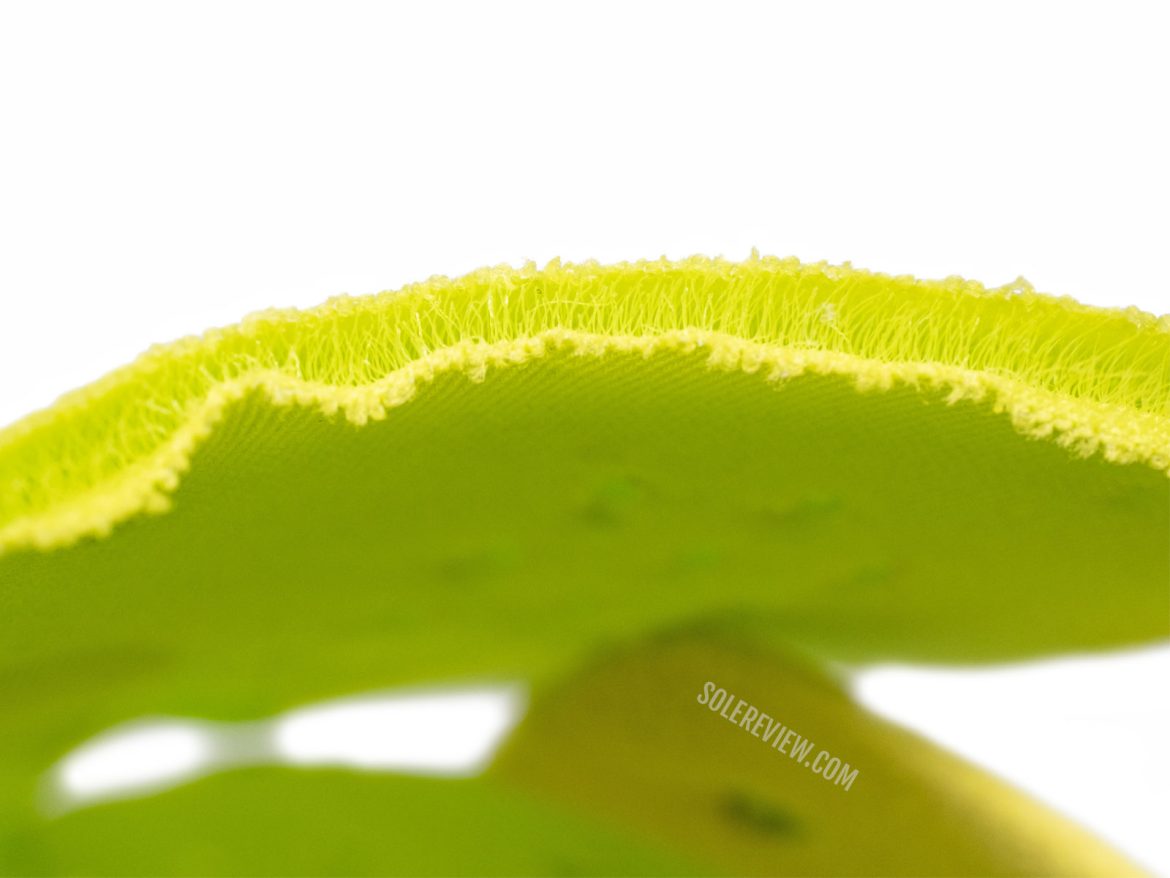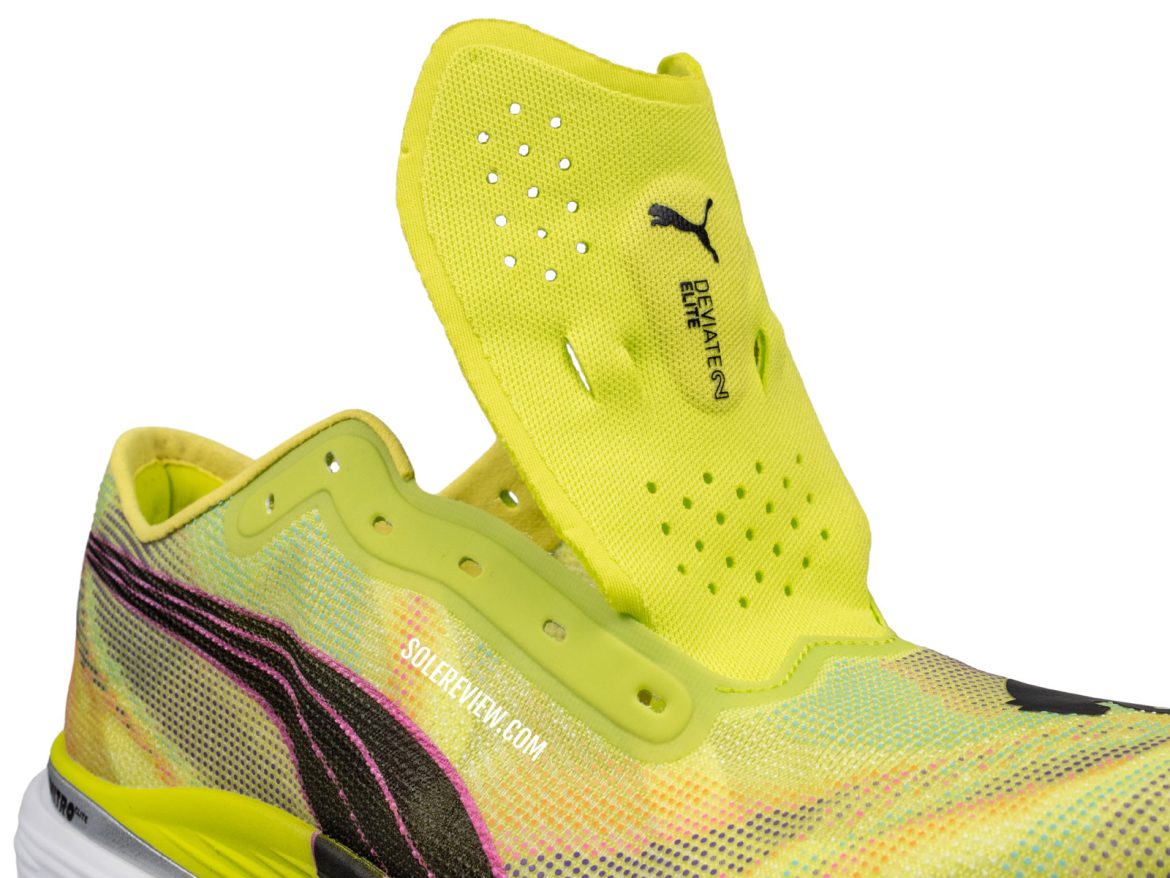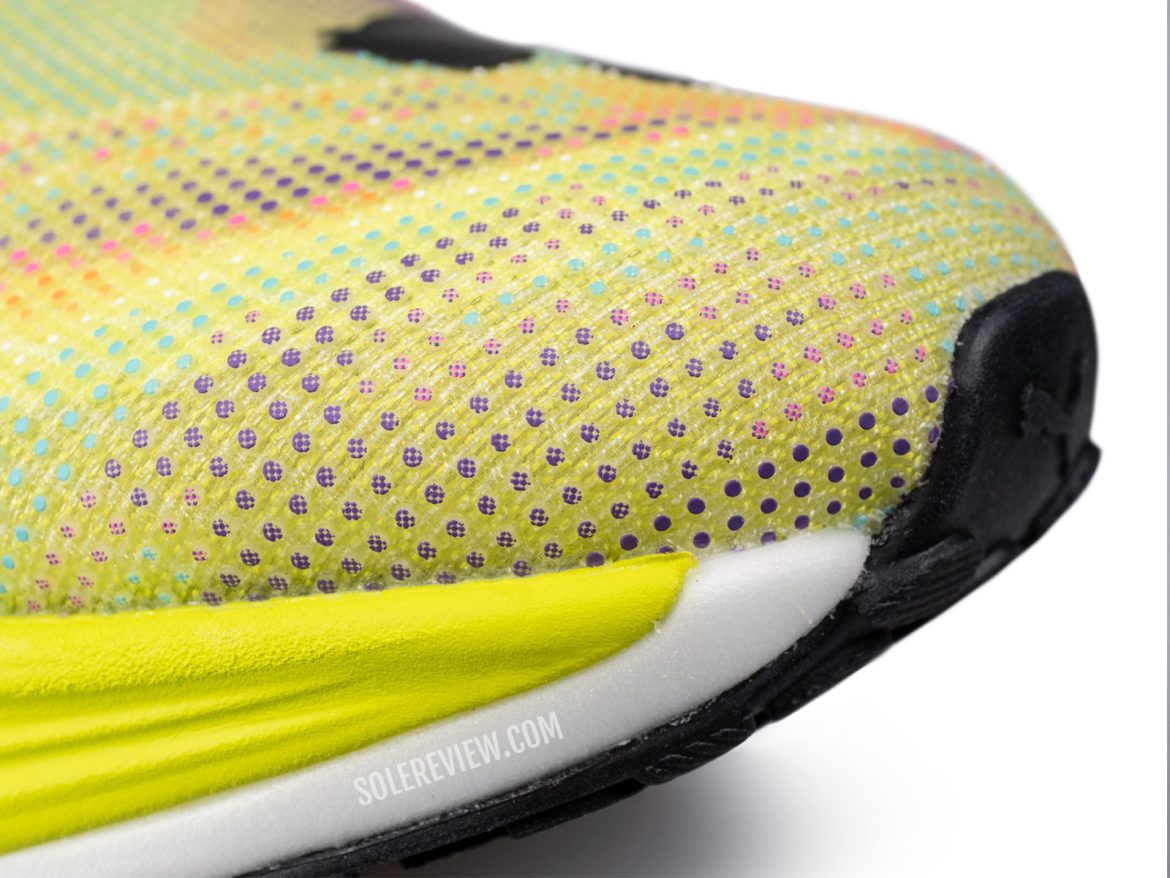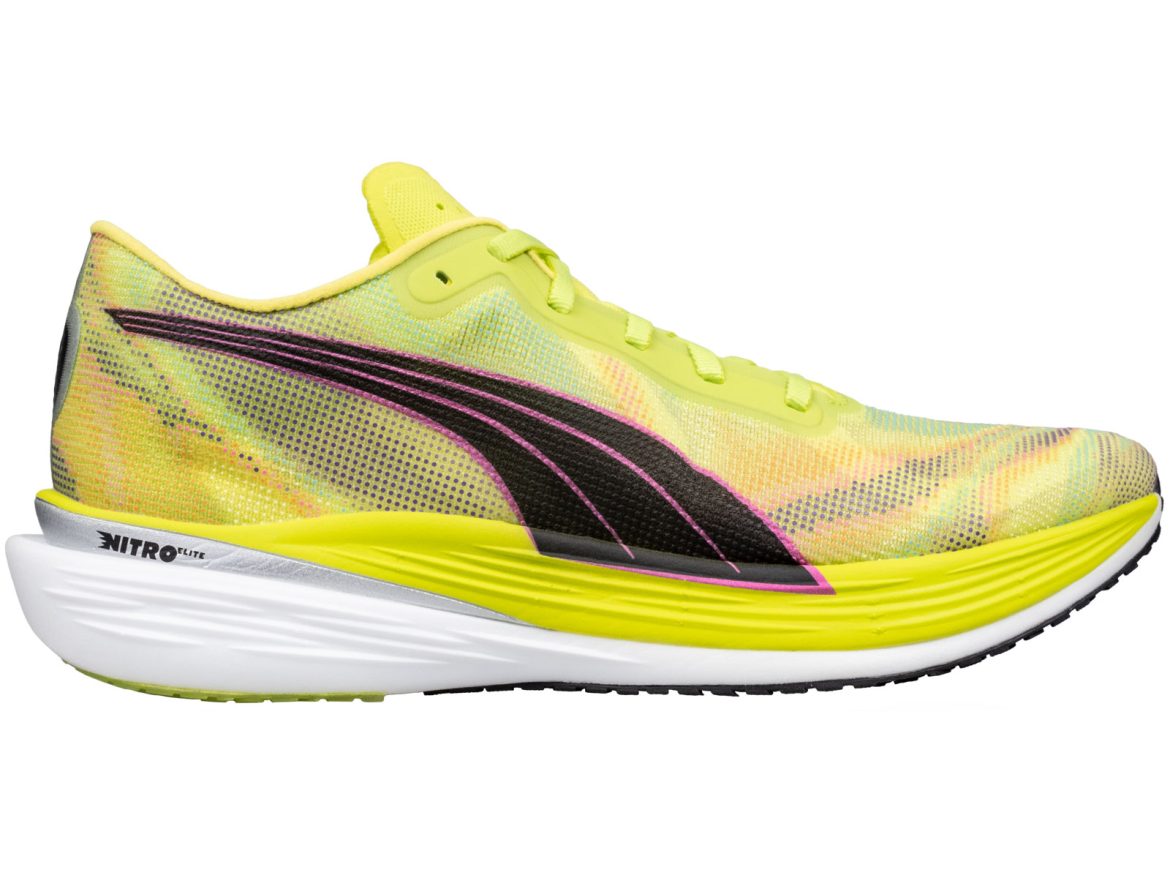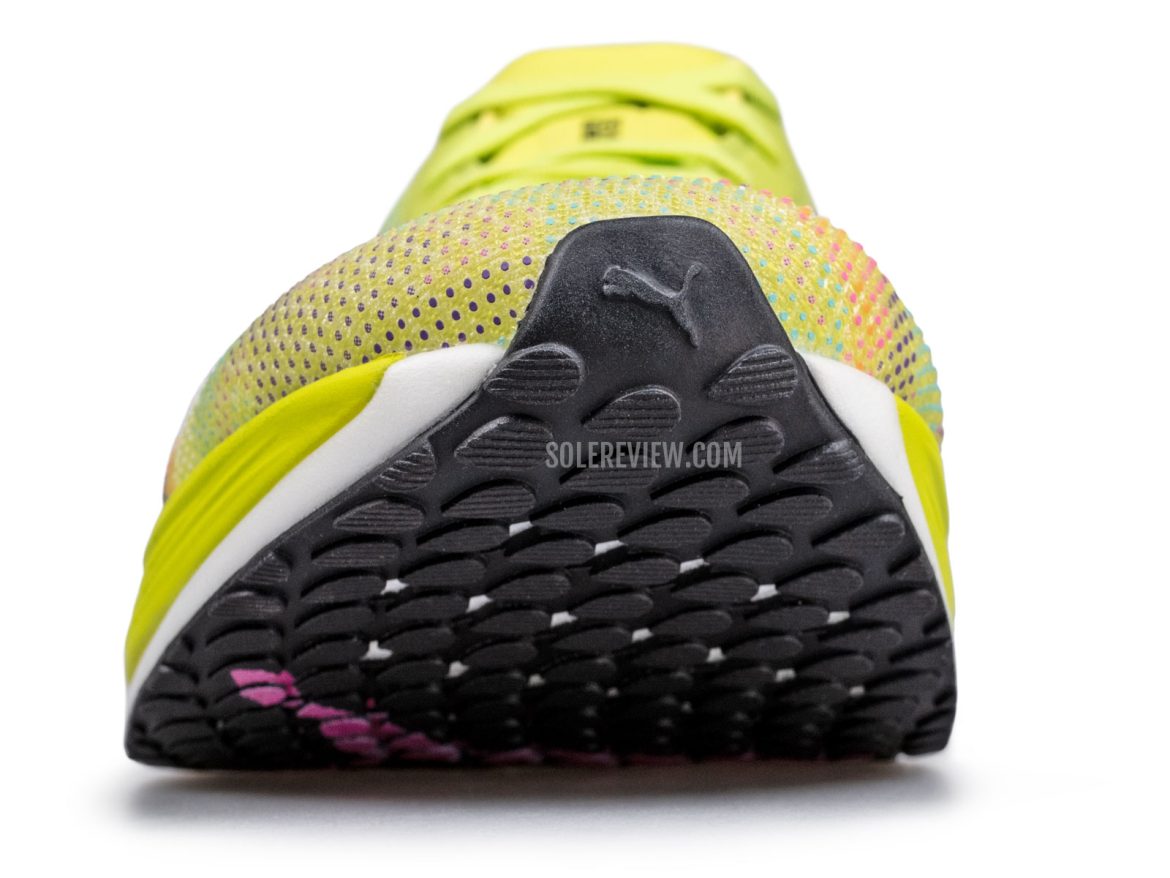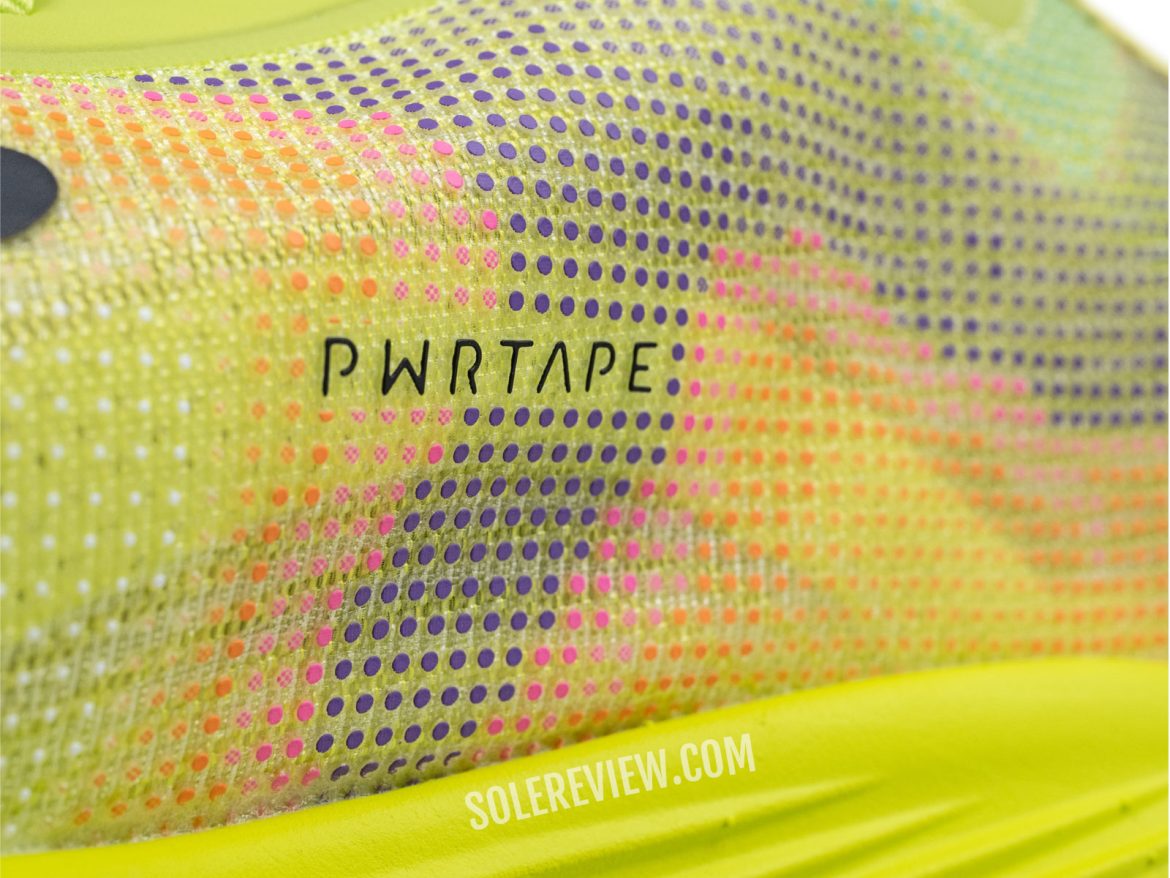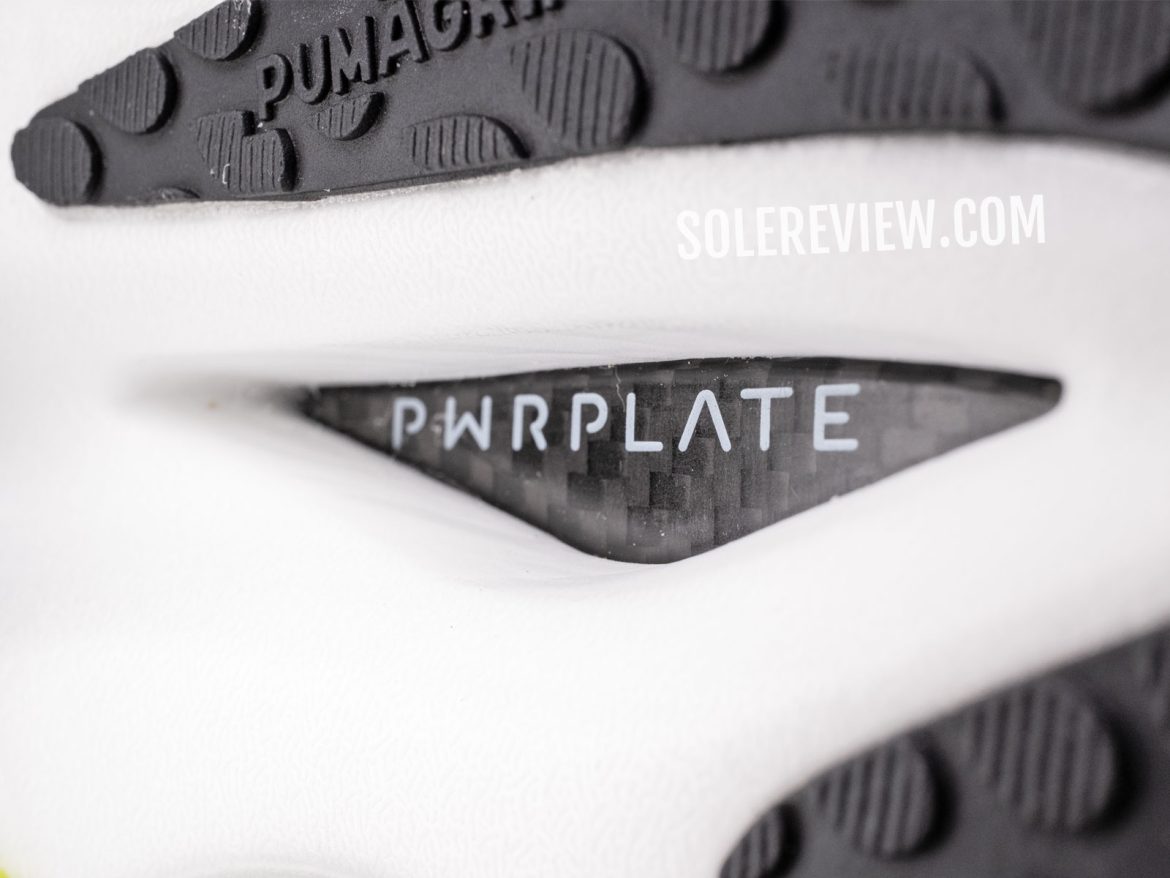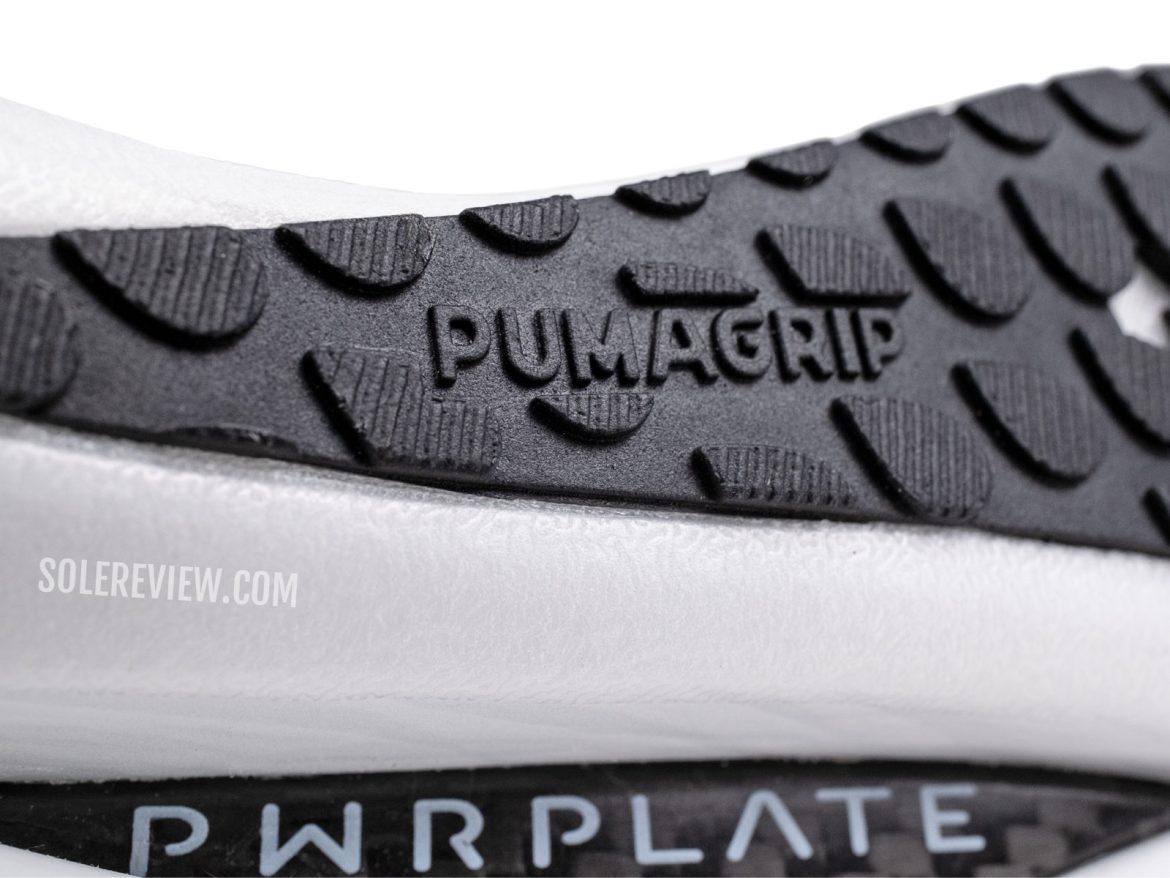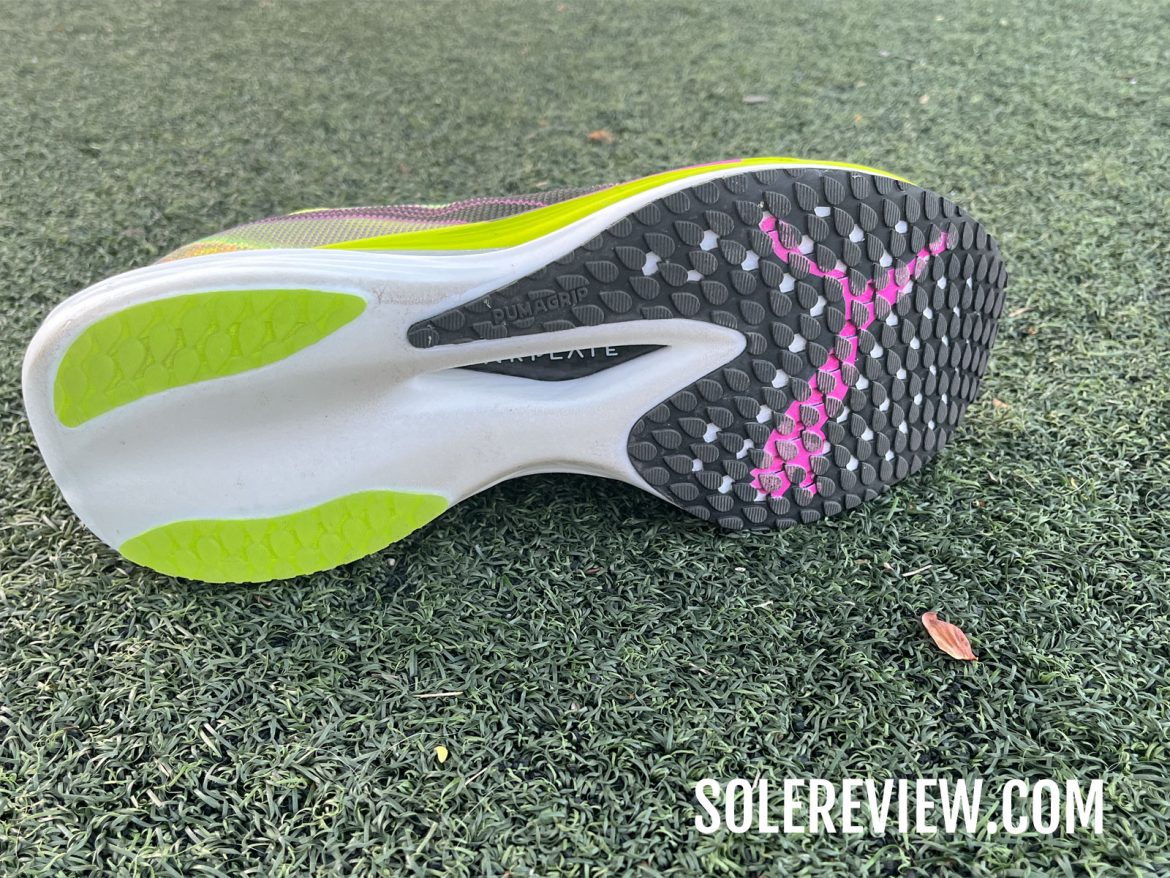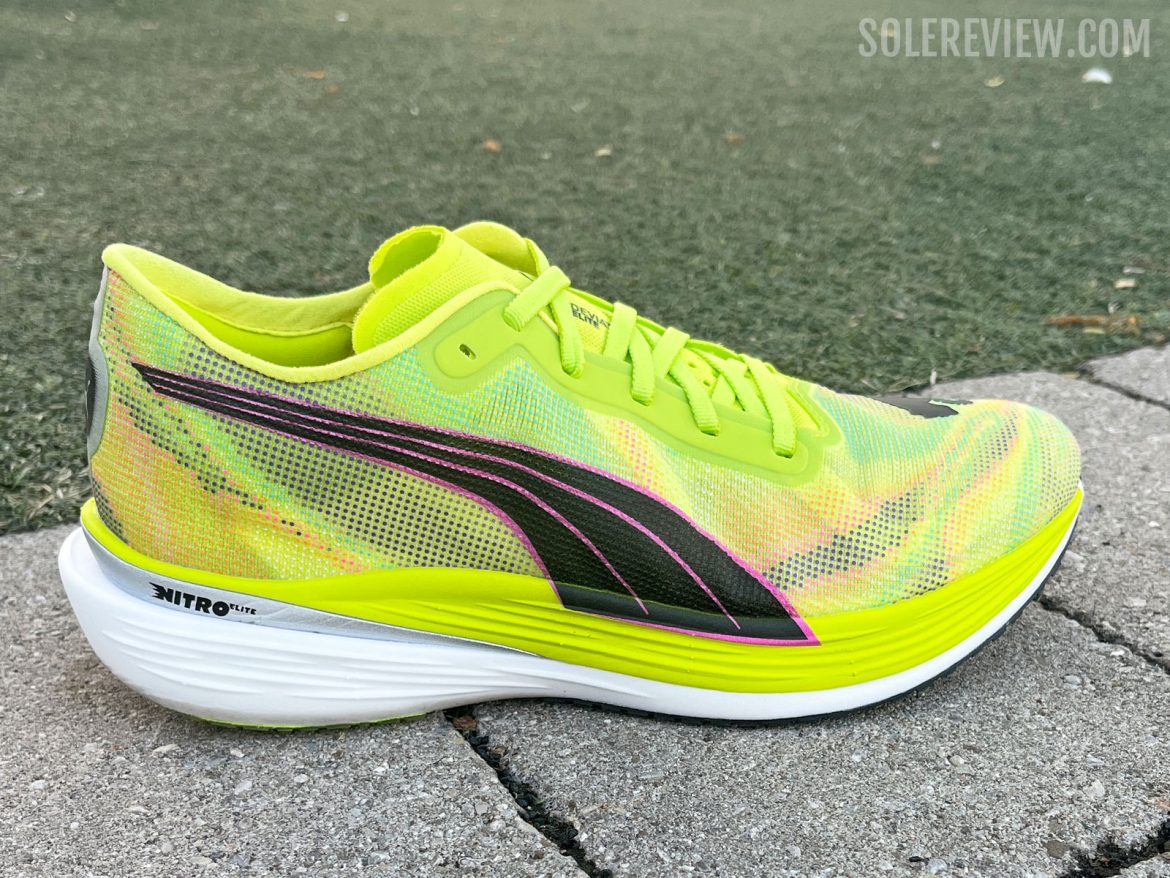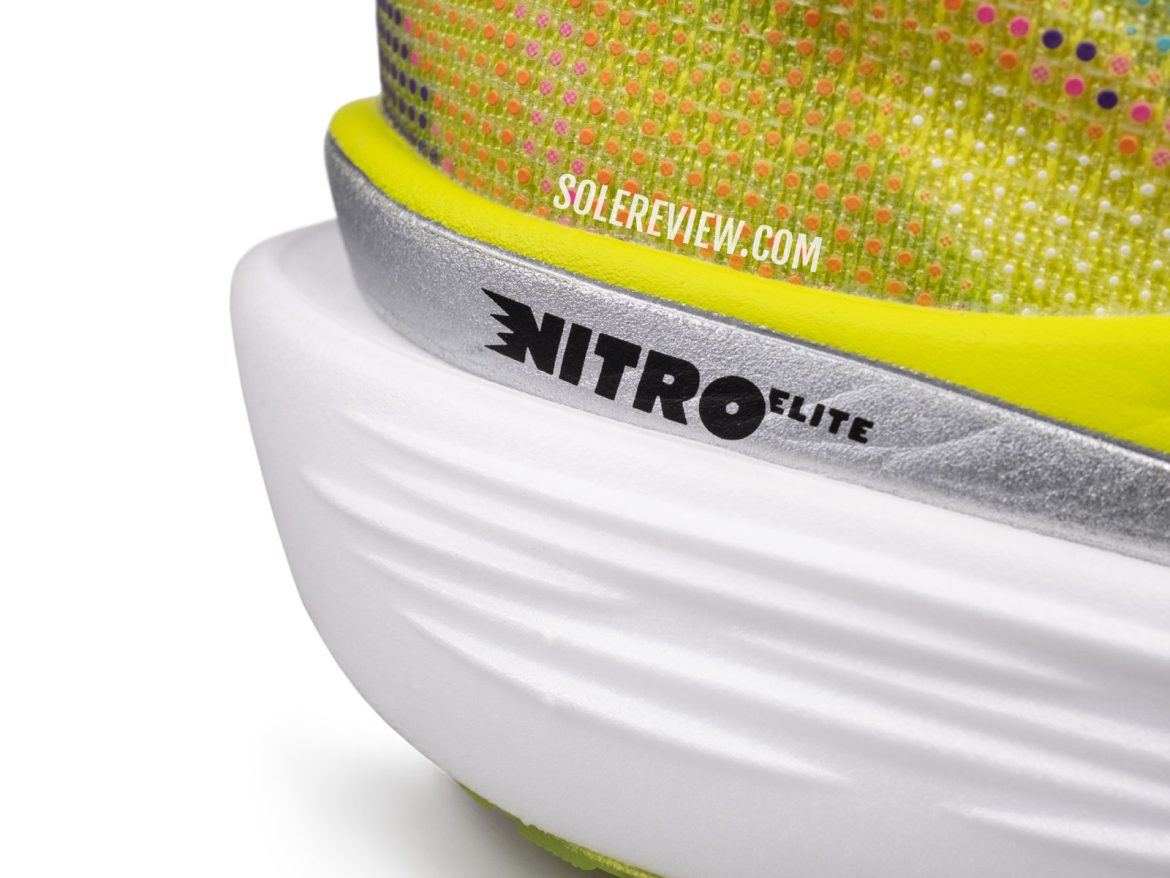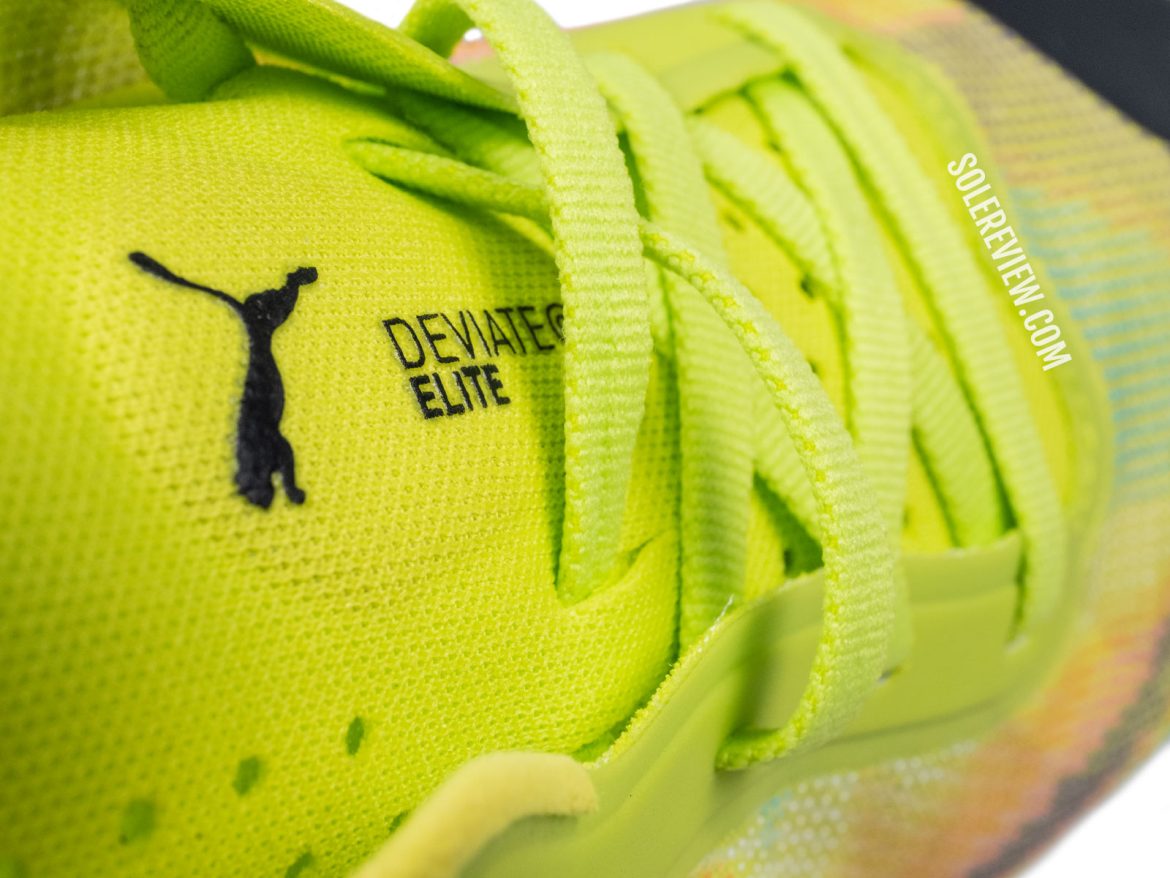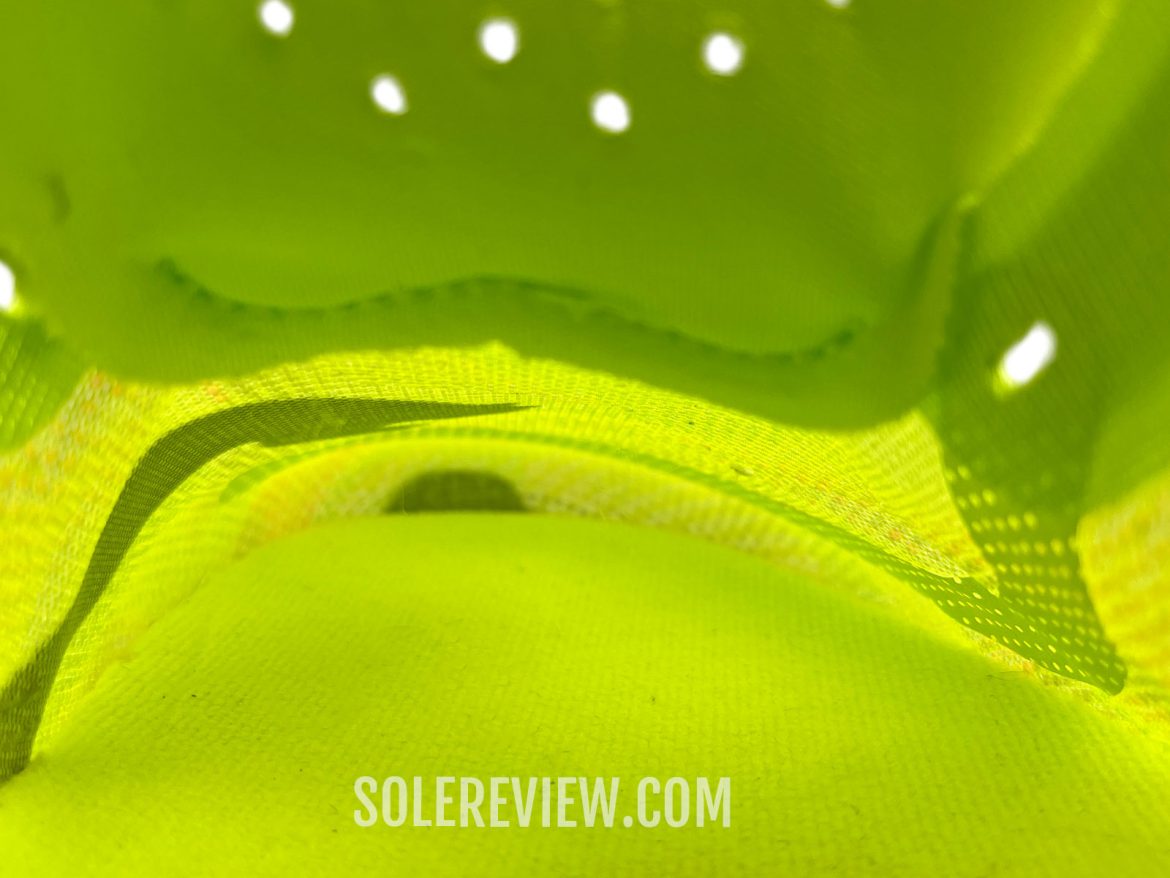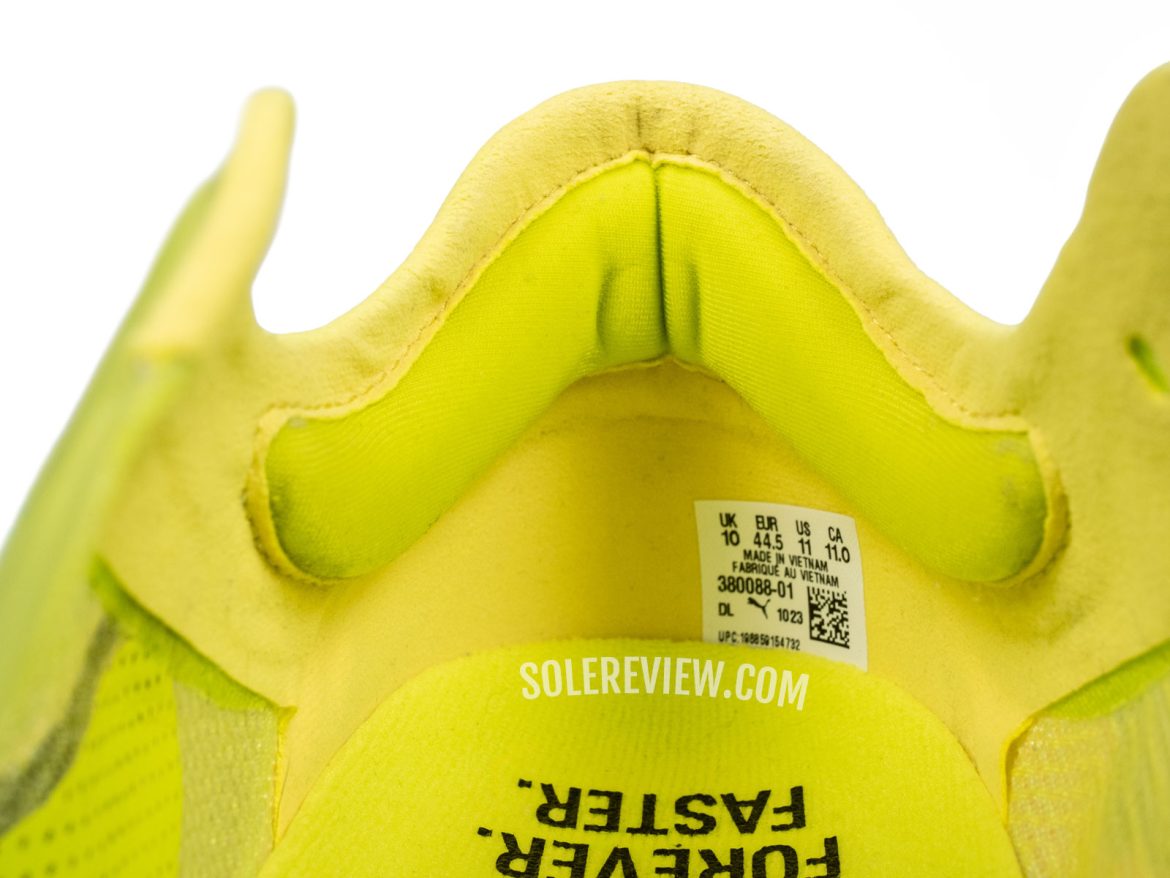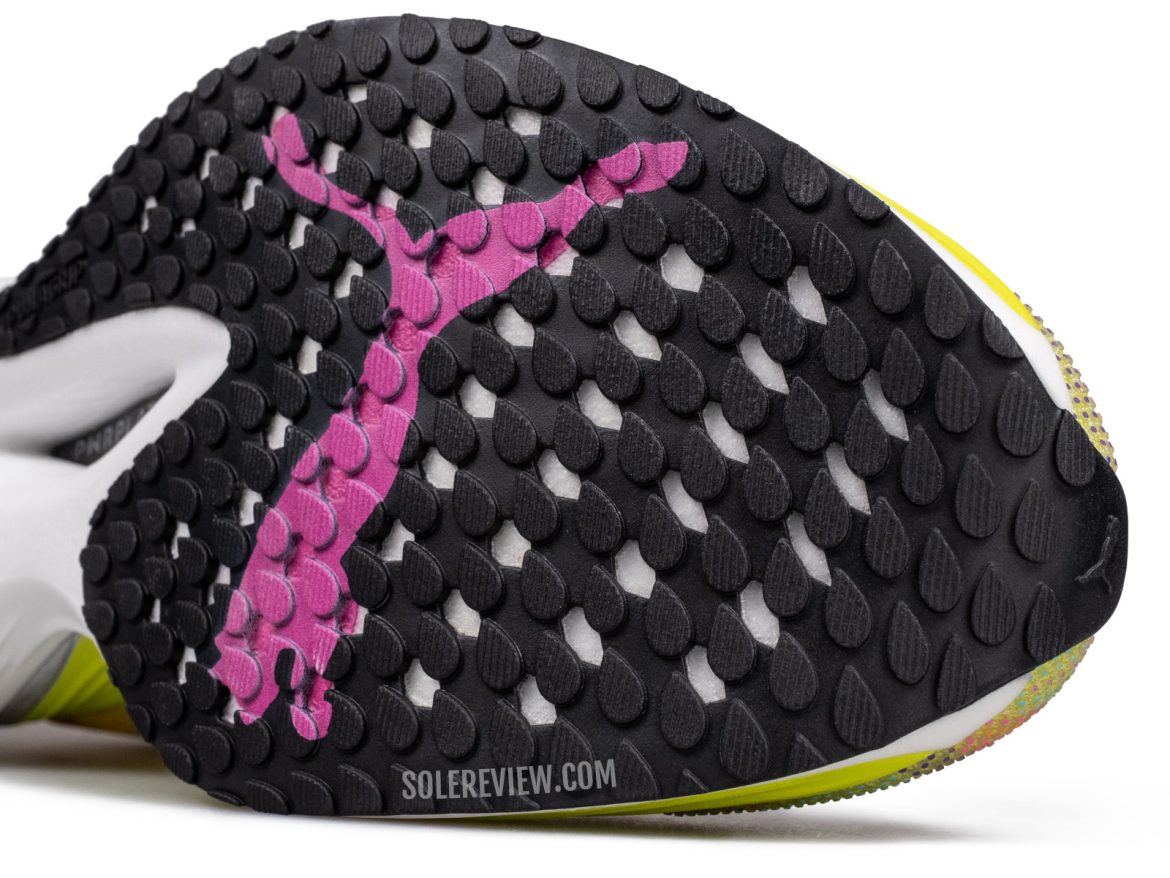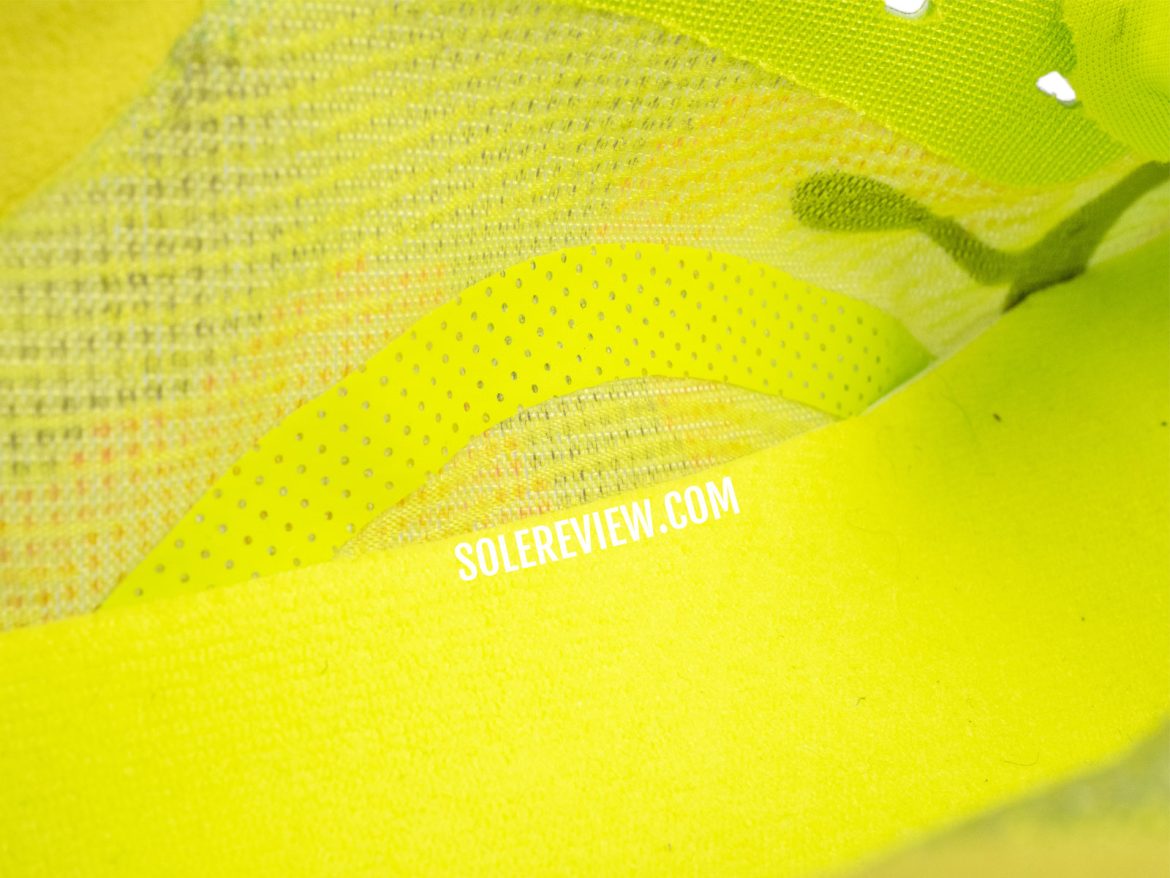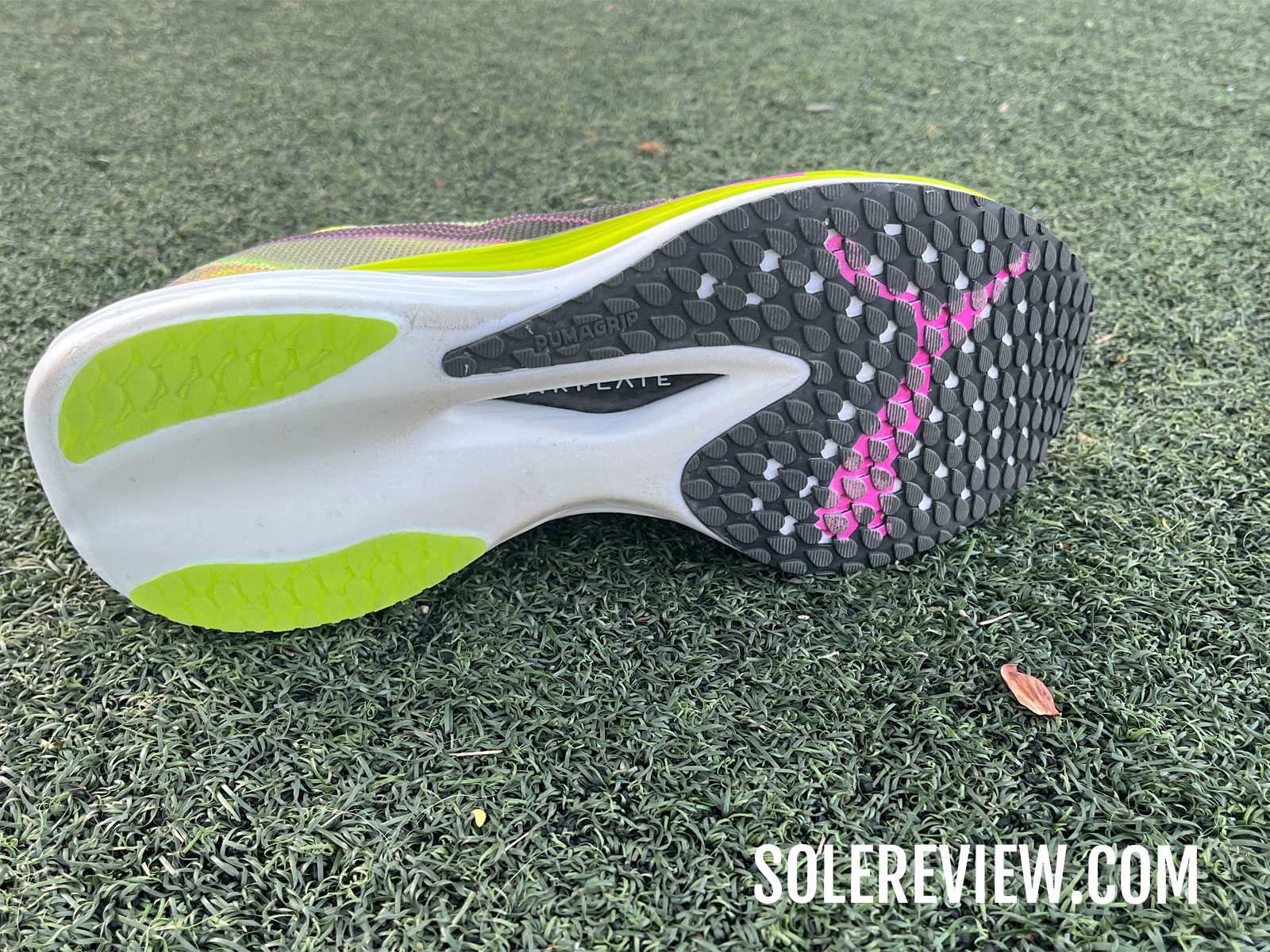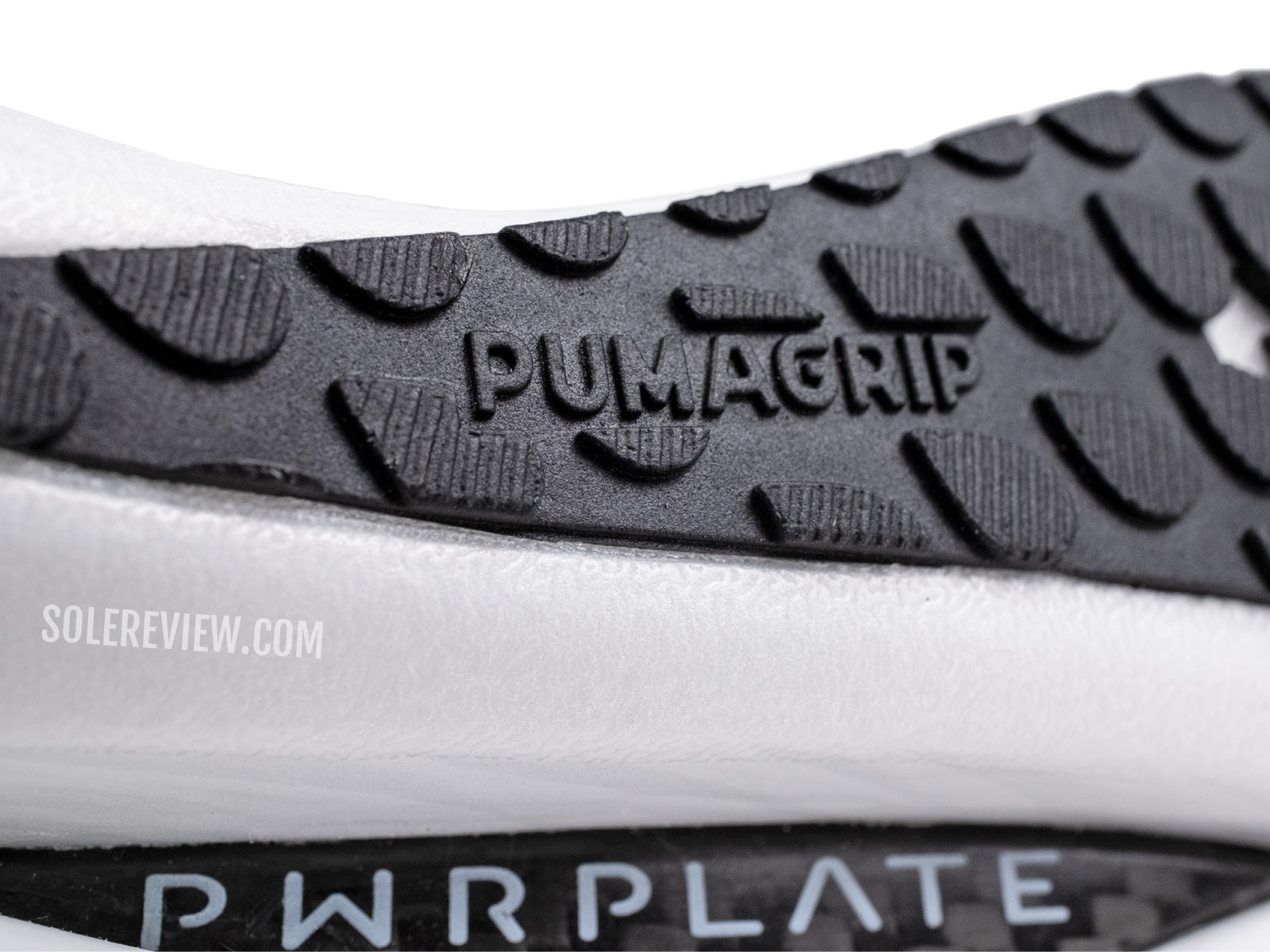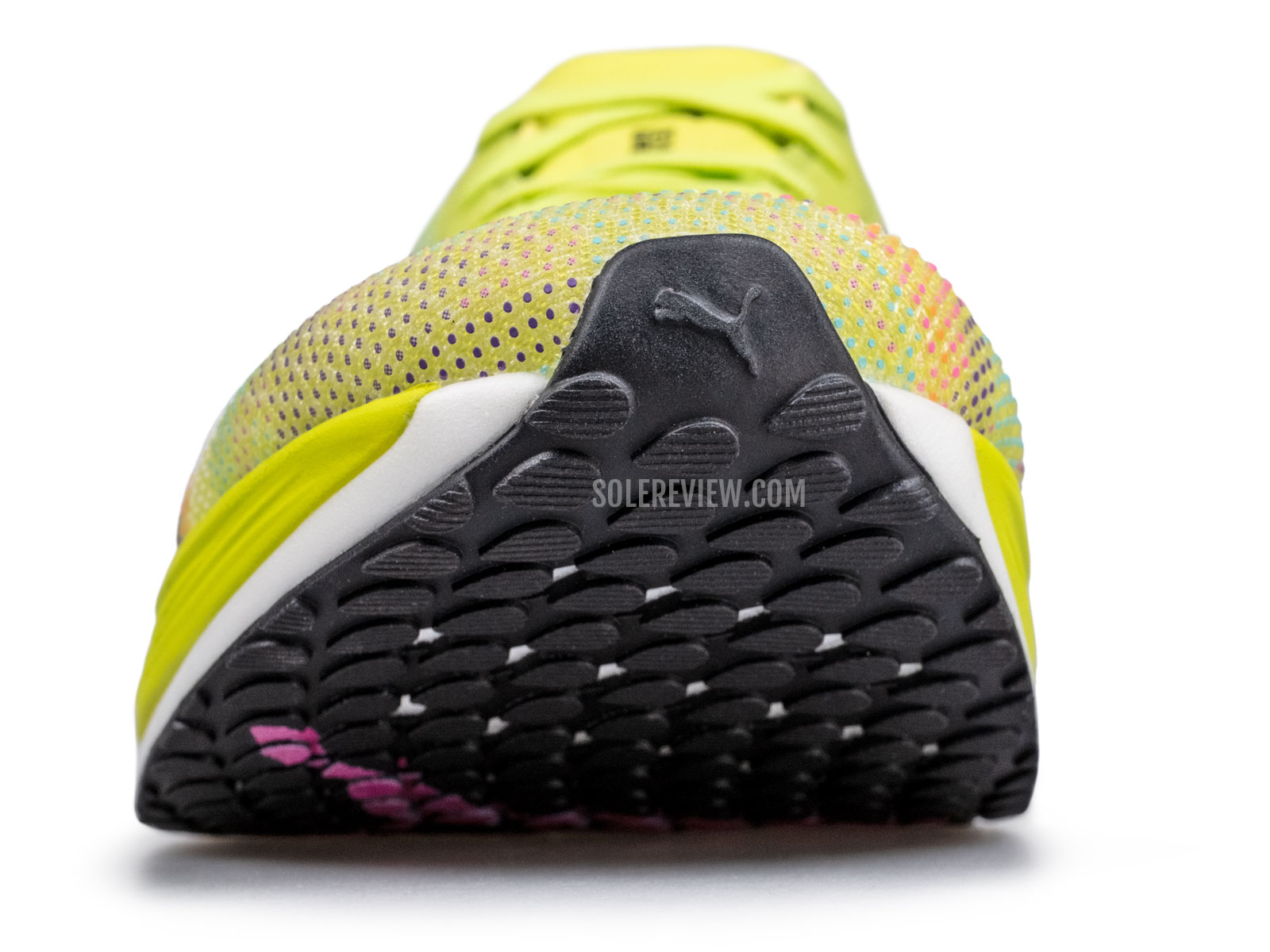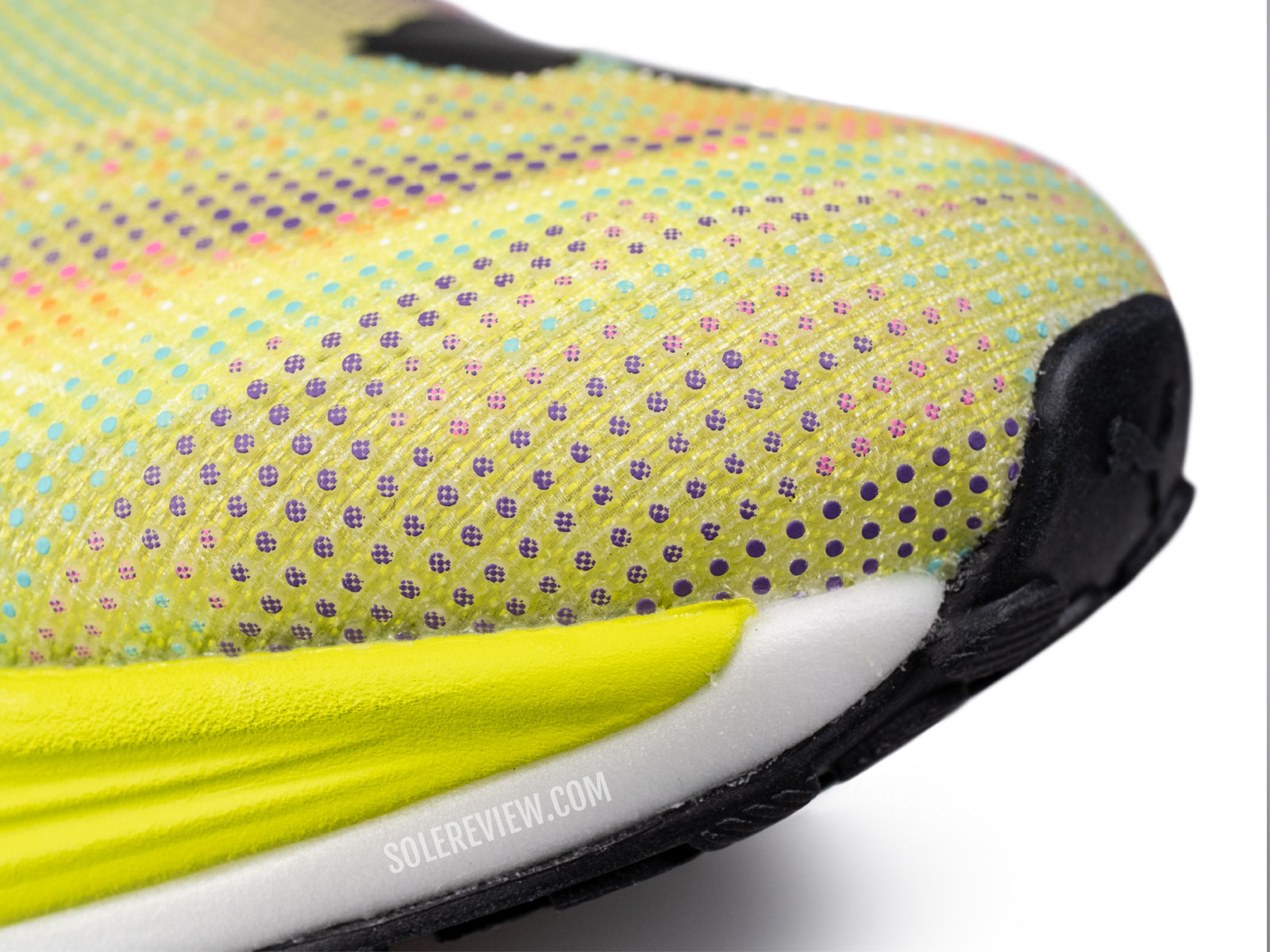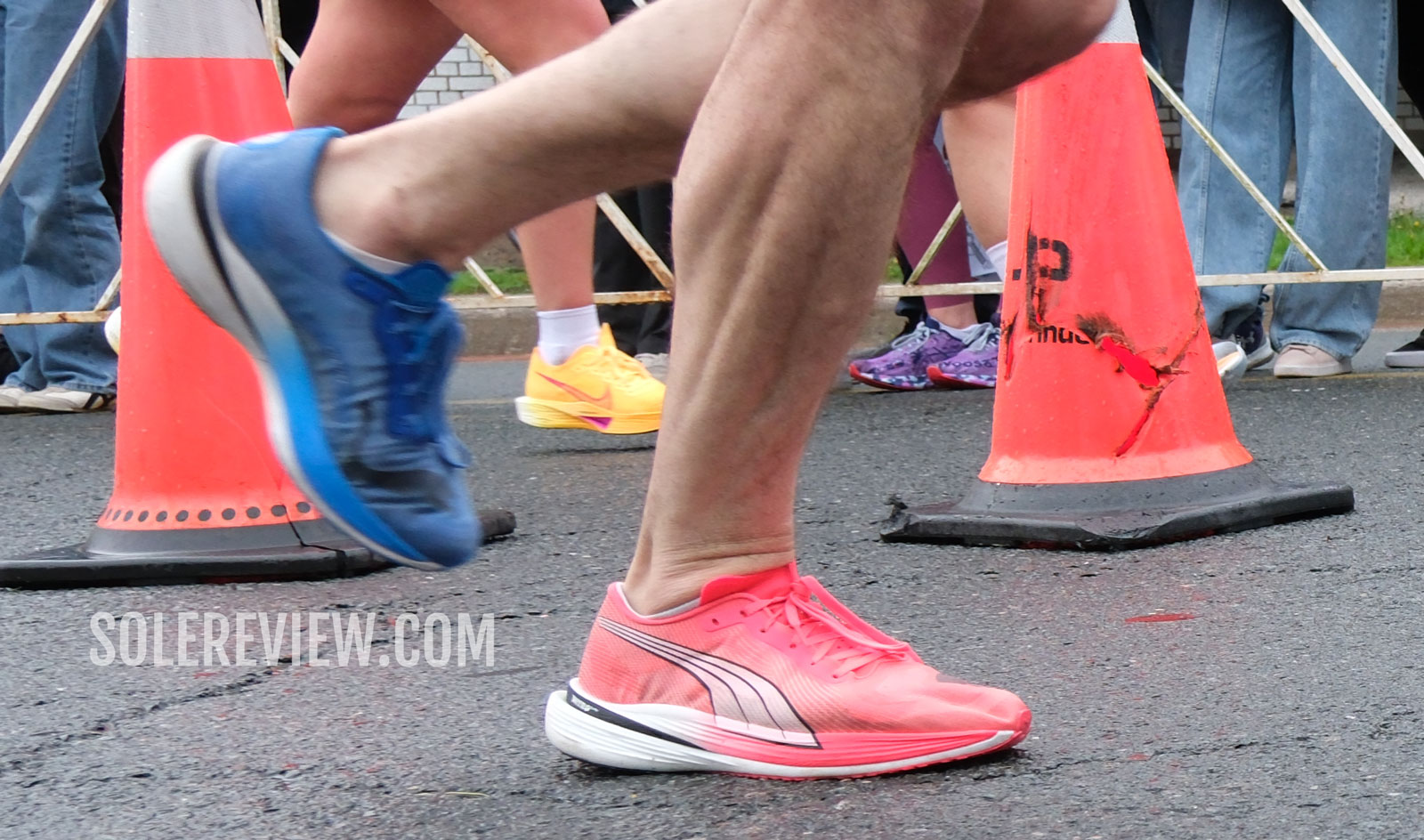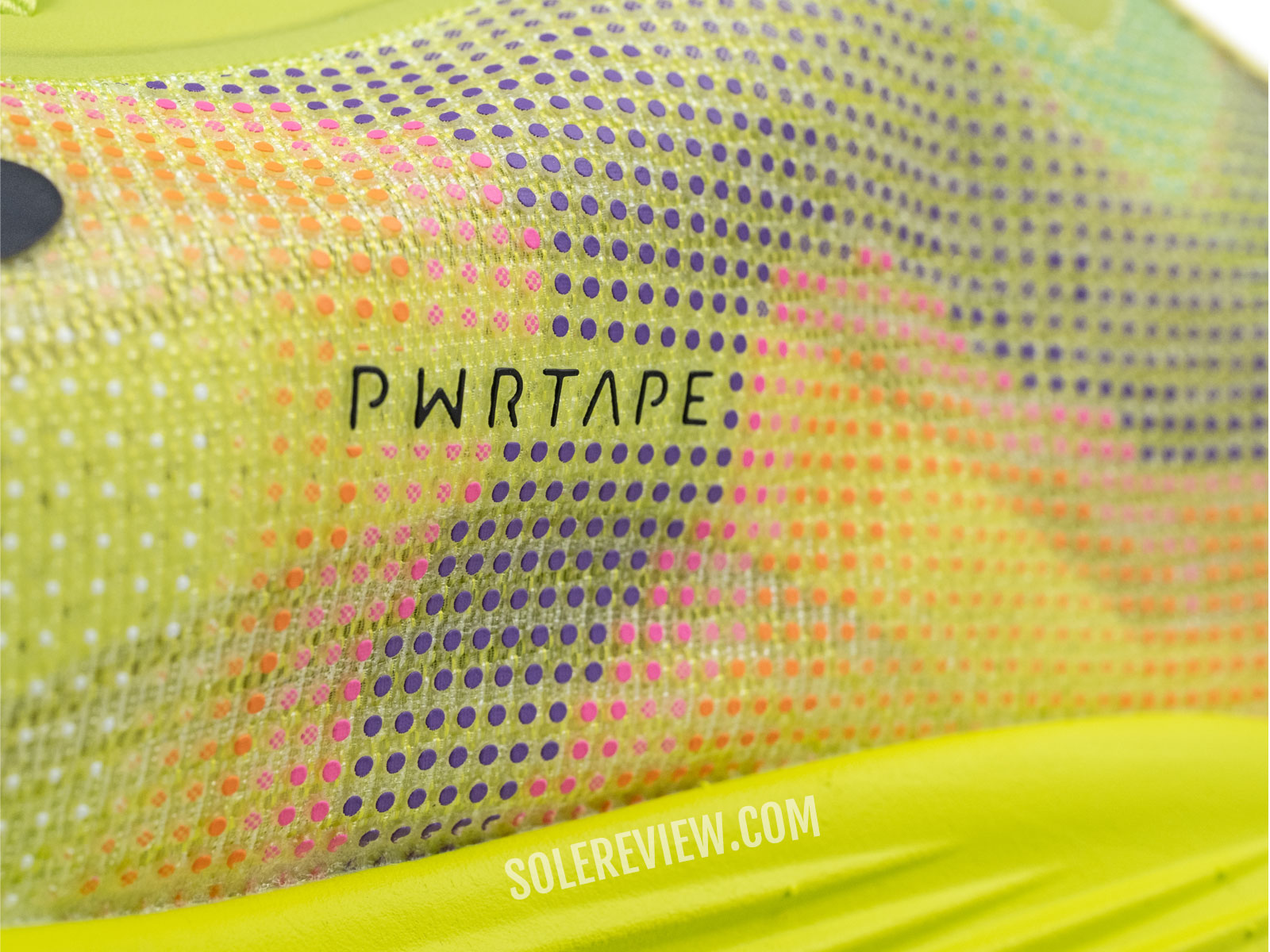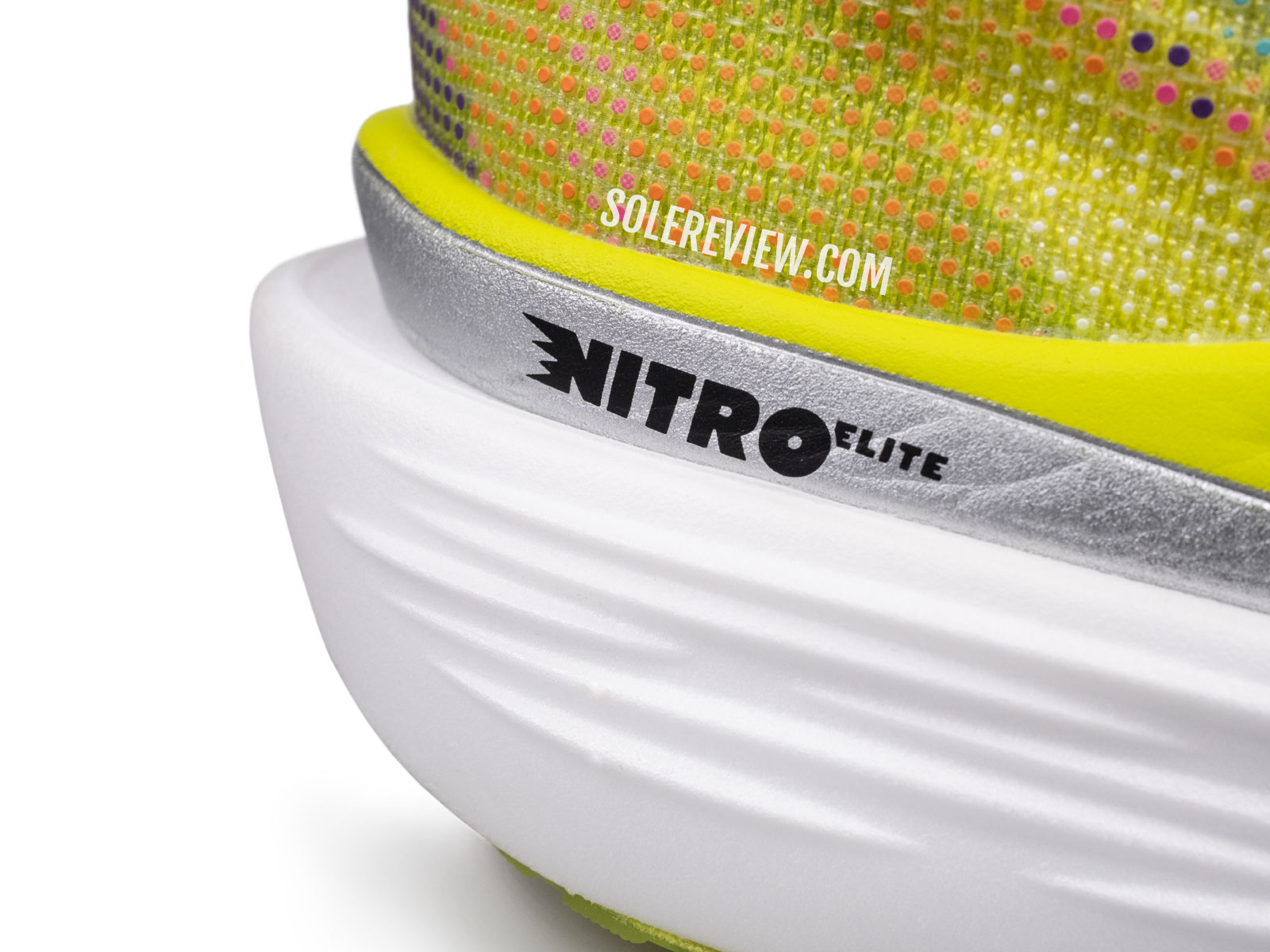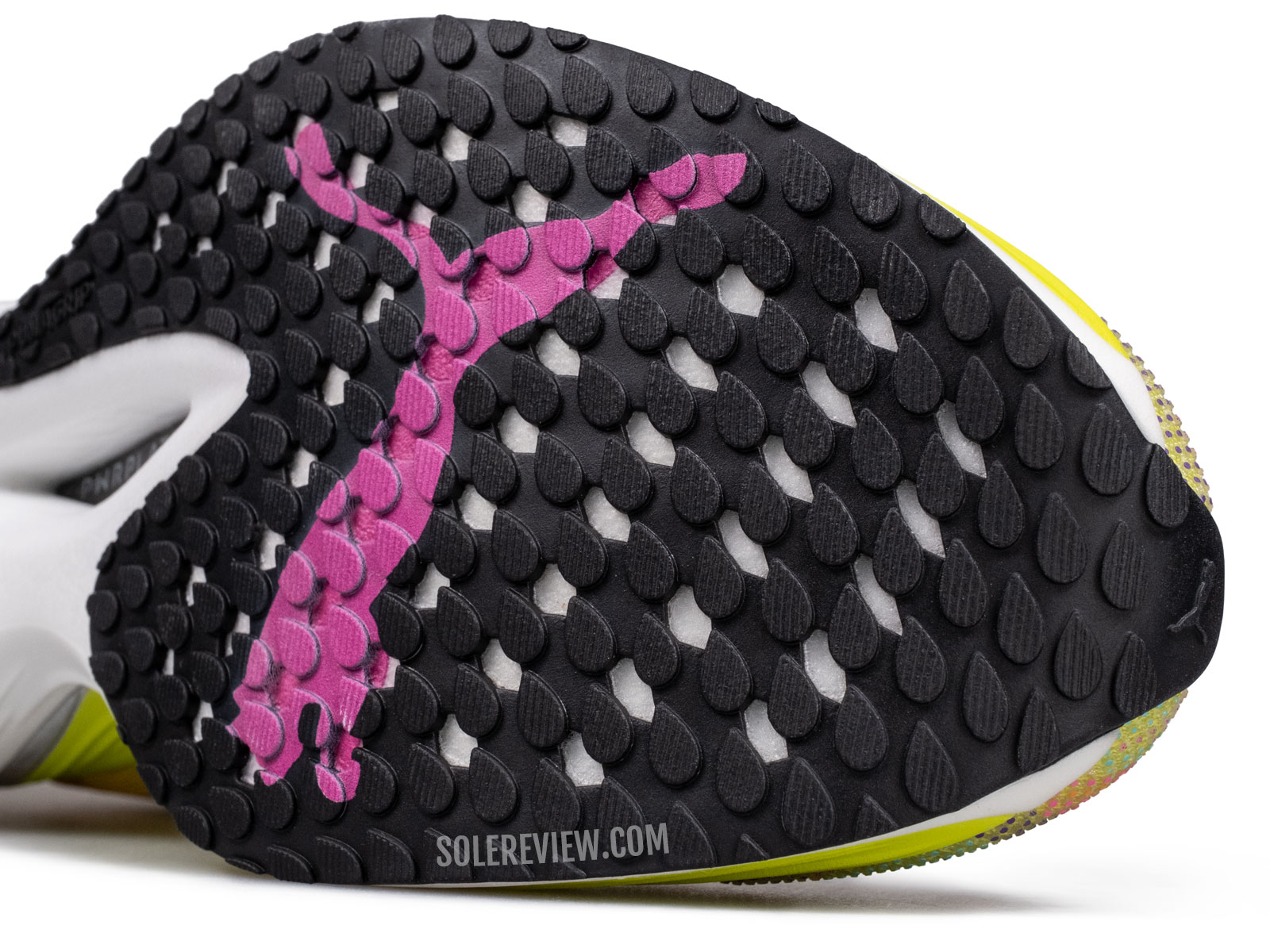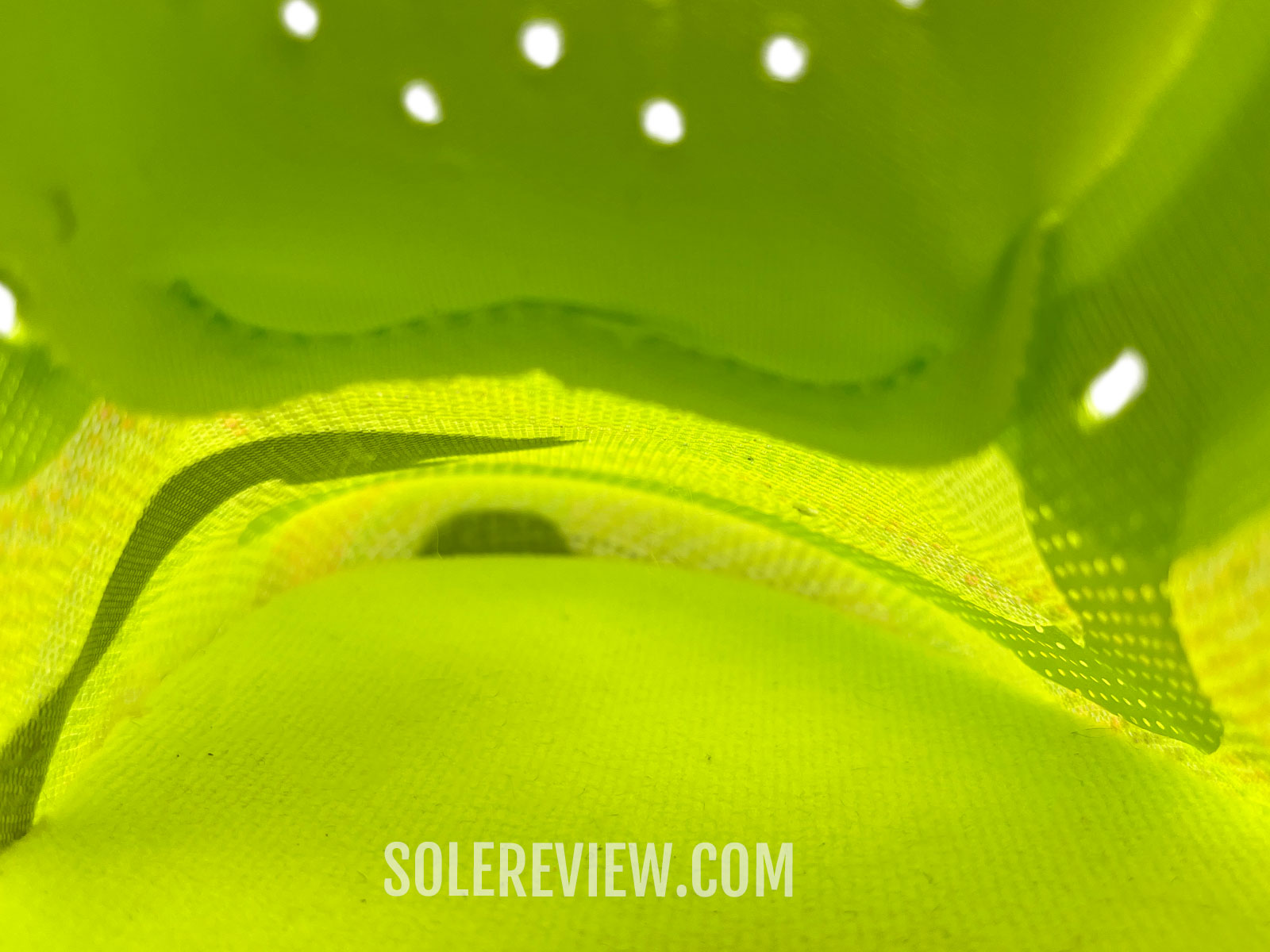- Puma’s marketing pitch: Redesigned for explosive, race-day propulsion.
- Upper: Mesh with high-density printing and fused taping.
- Midsole: Softer Nitro Elite foam over a firmer Nitro foam base. Carbon Pwrplate, 8 mm heel drop.
- Outsole: Pumagrip rubber.
- Weight: 212 gms/ 7.5 Oz for a half pair of Men’s US 9/UK 8.5/EUR 42.5/CM 27.
- Stack heights: 38 mm (heel), 30 mm (forefoot).
- Available widths: D – regular (reviewed).
- Previous model: Puma Deviate Nitro Elite.
- Country of origin: Vietnam.
- Recommended use: 5K, 10K races, intervals, half-marathons.
- Footstrike orientation: Heel, midfoot/forefoot (full contact).
- Recommended paces: Faster than 5:00 min/km (8:00 min/mile).
- Median lifespan: 350 miles.
- Recommended temperature range: Warmer than -5° C/23° F.
Pros
- Soft and bouncy ride
- Outsole grip
- Secure upper
- Excellent for short races
- Efficient transitions
Cons
- Pwrtape presses inwards over small toe
- Limited retail availability
- Upper too narrow for longer distances
- Average ventilation
Also consider:
- Hoka Carbon X3 – much firmer, but has similar intent
- adidas adios 8
- Brooks Hyperion Max
- Use the Deviate Nitro Elite 2 for short races and intervals
- Use the Saucony Ride 17 for everyday runs
- Use the adidas adios Pro 3 or Saucony Endorphin Pro 4 for marathons
The Deviate Nitro Elite 3 was released earlier this month, and Puma cleverly added ‘Proto’ to the shoe’s name. It seemed to have the same effect as the Nike Alphafly 3, and it’s sold out for now. That’s despite the steep $30 price increase from the DNE2 – the shoe we’re reviewing here.
We can’t speak for the kind of shoe that the new Deviate Nitro Elite 3 is, but we’ve got a good hang on the Deviate Nitro Elite 2. Or at least we think we do.
At first, we didn’t know what to make of the shoe. Is it similar to the popular Carbon plate racers like the Nike Vaporfly, Saucony Endorphin Pro, and their kind? Or does it compare with lower-profile trainers with a stiff component? Like the adidas Adios 8 or the Asics Metaracer (from a few years ago)?
The answer is neither. The Deviate Nitro Elite 2 doesn’t fit into an established segment. It’s much softer than shoes such as the Adios, yet lacks the strong rocker effect and stack heights of $250 – 300 racers. The DNE2 is a racier, low-calorie version of the Deviate Nitro 2 – another shoe that doesn’t fit into a stereotype.
It’s an odd one, just like the Hoka Carbon X3. We’re not implying that these two shoes are similar, but both are standalone models and esoteric in nature.
So what is the DNE2 good for, and what other things should one know about this shoe?
It’s an excellent plated shoe for 5K, 10K races and interval training
The combination of the relatively low-profile forefoot (30 mm), narrow fit, Carbon plate, and outsole grip make the DNE2 great for short races and speed training. The tight upper is great at directing the power to the midsole; the grippy outsole helps with quick push-offs.
Having the firmer Nitro foam (which feels similar to the Fuelcell Rebel 3) closer to the outsole also helps with the transitions. The softer Nitro Elite foam on top adds comfort during fast-paced workouts, but doesn’t overdo it. Even at 3:30 min/km (5:30 min/mile) speeds, the DNE2 feels efficient.
For runs that are longer than a half-marathon, a shoe with more upper room and a stronger midsole rocker will work better.
The midsole has a mild rocker effect
Even though the stiff midsole has a curved Carbon plate, the rocker effect isn’t very aggressive. The toe spring – which is the height between the tip of the shoe and the ground – isn’t all that different from a regular trainer.
In short, the DNE2 doesn’t have the pronounced ‘roll forward’ effect that shoes like the Nike Vaporfly 3 and Saucony Endorphin Pro 4 have.
The narrow fit is true-to-size and shallow
The DNE2’s upper fit has something in common with the Deviate Nitro 2 – the toe-box isn’t cramped, but the forefoot is. The upper fits narrow around the forefoot, with tightness felt over the small toe. The mesh doesn’t have any give, and that too, leads to a cramped environment.
There’s no sleeve inside the midfoot, but that doesn’t negatively affect the fit. The wide tongue is made of a spongy spacer mesh and uses dual loops to prevent it from sliding.
While the collapsible heel lacks a stiff heel counter, the foam pods grip well without slippage.
Not bad for a marathon, but there are better choices
On the surface, the DNE2 seems to have everything that an ideal marathon racer needs. It’s lightweight (7.5 ounces), has a super-foam midsole, a Carbon plate, and respectable stack heights.
However, it’s not at the same level as established plated racers. You don’t get the noticeable roll-off assist that comes with a defined midsole rocker (which the DNE2 lacks), nor does one benefit from a noticeable springboard effect under the heel.
The soft and bouncy combo midsole (Nitro and Nitro Elite) has plenty of ride comfort, but that’s offset by the narrow and warm upper. During a longer race, upper comfort is of equal importance. There’s a thin line between a secure fit and a narrow one, and the DNE2 is in the narrow camp.
It’s not a bad marathon shoe per se, but there are better shoes out there.
The upper feels plasticky, and ‘Pwrtape’ feels intrusive
In our Deviate Nitro 2 review, we mentioned that Puma’s Pwrtape means different things on different shoes. On the DNE2, Pwrtape is exactly what it sounds like – a fused tape that runs inside the midfoot and under the toe-box.
The Pwrtape inside the toe-box is somewhat invasive. Not only does it make the toe-box shallow, but it also presses down on the small toe when flexed. The DNE2 would have been served better with a traditional toe bumper.
The Deviate Nitro Elite 2 works for heel landings
While the DNE2’s soft heel isn’t as stable as daily trainers, it’s not a bad shoe for heel strikers. The lower base (made of the firmer Nitro foam) is wider than the upper midsole, and the sidewalls have a balanced (neutral) geometry.
The stability would improve with a stiffer heel counter; the one inside the DNE2 is very flexible and tiny.
Pumagrip rubber has superlative traction
Another German brand – adidas – has established itself as a brand with grippy outsoles. So it’s only fitting that another German shoe-maker offers superior outsole traction.
The Pumagrip outsole covers most of the forefoot and that translates into superlative grip on most surface conditions. The generous Pumagrip coverage also helps with quick turnovers – not just because of the traction, but also due to the stiffness it provides. The Deviate Nitro 2 would have also benefited from a similar layout.
The upper doesn’t breathe very well
Here, you won’t find the levels of ventilation that plated racers from adidas, Nike, and Saucony offer. The mesh is covered with high-density printing, and the tight fit isn’t great at letting the air circulate.

